Investigation of Energy Absorbed by Composite Panels with Honeycomb Aluminum Alloy Core
Abstract
:1. Introduction
- To determine how much energy the investigated composite panels can absorb in bending and compare the results with the ones obtained in previous research [31].
- To verify if the panels absorb at least the same amount of energy in bending as 25 × 1.75 mm 1.0562 alloy steel tubes, which can be used to construct the chassis (space frame) of a motorsport vehicle due to good welding and strength properties, as well as for economic reasons. This comparison is important from an application point of view since a monocoque chassis made from composite panels exhibits much higher torsional stiffness compared to a steel space frame, which is more favorable in motorsports.
2. Materials and Methods
2.1. Materials and Layup
2.2. Test Machine Setup
2.3. Three-Point Bending Test Setup
2.4. Perimeter Shear Test Setup
2.5. Steel Tubes Test Setup
3. Results
3.1. Three-Point Bending Test Results
3.2. Perimeter Shear Test Results
4. Discussion and Conclusions
Author Contributions
Funding
Acknowledgments
Conflicts of Interest
References
- Zhu, D.; Shi, H.; Fang, H.; Liu, W.; Qi, Y.; Bai, Y. Fiber reinforced composites sandwich panels with web reinforced wood core for building floor applications. Compos. Part B Eng. 2018, 150, 196–211. [Google Scholar] [CrossRef]
- Bull, P.; Edgren, F. Compressive strength after impact of CFRP-foam core sandwich panels in marine applications. Compos. Part B Eng. 2004, 35, 535–541. [Google Scholar] [CrossRef]
- Francesconi, A.; Giacomuzzo, C.; Kibe, S.; Nagao, Y.; Higashide, M. Effects of high-speed impacts on CFRP plates for space applications. Adv. Space Res. 2012, 50, 539–548. [Google Scholar] [CrossRef]
- Xia, Q.; Mei, H.; Zhang, Z.; Liu, Y.; Liu, Y.; Leng, J. Fabrication of the silver modified carbon nanotube film/carbon fiber reinforced polymer composite for the lightning strike protection application. Compos. Part B Eng. 2020, 180, 107563. [Google Scholar] [CrossRef]
- SAE International. Formula SAE Rules 2019 v2.1; SAE International: Warrendale, PA, USA, 2018; pp. 36–37. [Google Scholar]
- Akiwate, S.B.; Shinde, V.D. Experimental Investigation of Bending behaviour of Aluminium Alloy Honeycomb Sandwich Structure using Four Point Bending Tests. Int. J. Innov. Res. Sci. Technol. 2017, 4, 2349–6010. [Google Scholar]
- Hou, S.; Zhao, S.; Ren, L.; Han, X.; Li, Q. Crashworthiness optimization of corrugated sandwich panels. Mater. Des. 2013, 51, 1071–1084. [Google Scholar] [CrossRef]
- Kara, E.; Crupi, V.; Epasto, G.; Guglielmino, E.; Aykul, H. Flexural behaviour of glass fiber reinforced aluminium honeycomb sandwiches in flatwise and edgewise positions. In Proceedings of the 16th European Conference on Composite Materials, ECCM 2014, Seville, Spain, 22–26 June 2014. [Google Scholar]
- Li, Z.; Ma, J. Experimental Study on Mechanical Properties of the Sandwich Composite Structure Reinforced by Basalt Fiber and Nomex Honeycomb. Materials 2020, 13, 1870. [Google Scholar]
- Akay, M.; Hannah, R. A comparison of honeycomb-core and foam core CarbonFibre/Epoxy sandwich Panels. Composites 1990, 21, 325–331. [Google Scholar] [CrossRef]
- Yaqoob, M. Fabrication and structural equivalency analysis of cfrp nomex core sandwiched panels for fsae race car. UNSW Canberra Adfa J. Undergrad. Eng. Res. 2017, 12. Available online: https://ojs.unsw.adfa.edu.au/index.php/juer/article/view/1084 (accessed on 1 December 2020).
- Yu, H.; Zhao, H.; Shi, F. Bending Performance and Reinforcement of Rocker Panel Components with Unidirectional Carbon Fiber Composite. Materials 2019, 12, 3164. [Google Scholar] [CrossRef] [Green Version]
- Xiao, Y.; Hu, Y.; Zhang, J.; Song, C.; Huang, X.; Yu, J.; Liu, Z. The Bending Responses of Sandwich Panels with Aluminium Honeycomb Core and CFRP Skins Used in Electric Vehicle Body. Adv. Mater. Sci. Eng. 2018, 2018, 5750607. [Google Scholar] [CrossRef] [Green Version]
- Shi, S.; Sun, Z.; Hu, X.; Chen, H. Flexural strength and energy absorption of carbon-fiber–aluminum-honeycomb composite sandwich reinforced by aluminum grid. Thin-Walled Struct. 2014, 84, 416–422. [Google Scholar] [CrossRef]
- Zhang, Y.; Zong, Z.; Liu, Q.; Ma, J.; Wu, Y.; Li, Q. Static and dynamic crushing responses of CFRP sandwich panels filled with different reinforced materials. Mater. Des. 2017, 117, 396–408. [Google Scholar] [CrossRef]
- Sun, Z.; Hu, X.; Sun, S.; Chen, H. Energy-absorption enhancement in carbon-fiber aluminum-foam sandwich structures from short aramid-fiber interfacial reinforcement. Compos. Sci. Technol. 2013, 77, 14–21. [Google Scholar] [CrossRef]
- Tomizawa, N.; Tsujimoto, T.; Itoh, K.; Ogino, T.; Nakamura, K.; Hara, S. Numerical and experimental study of crashworthiness parameters of honeycomb structures. Thin-Walled Struct. 2014, 78, 87–94. [Google Scholar]
- Thomas, T.; Tiwari, G. Energy absorption and in-plane crushing behavior of aluminium reinforced honeycomb. Vacuum 2019, 166, 364–369. [Google Scholar] [CrossRef]
- Xie, S.; Zhou, H. Analysis and optimisation of parameters influencing the out-of-plane energy absorption of an aluminium honeycomb. Thin-Walled Struct. 2015, 89, 169. [Google Scholar] [CrossRef]
- Ivañez, I.; Fernandez-Cañadas, L.; Sanchez-Saez, S. Compressive deformation and energy-absorption capability of aluminium honeycomb core. Compos. Struct. 2017, 174, 123–133. [Google Scholar] [CrossRef]
- Crupi, V.; Epasto, G.; Guglielmino, E. Collapse modes in aluminium honeycomb sandwich panels under bending and impact loading. Int. J. Impact Eng. 2012, 43, 6–15. [Google Scholar]
- Ashby, M.F. Chapter 4—Material Property Charts. In Materials Selection in Mechanical Design, 4th ed.; Ashby, M.F., Ed.; Butterworth-Heinemann: Oxford, UK, 2011; pp. 57–96. [Google Scholar]
- Story, R. Design of Composite Sandwich Panels for A Formula SAE Monocoque Chassis; Oregon State University: Corvallis, OR, USA, 2014. [Google Scholar]
- Walker, M. Structural Equivalency Analysis of Aluminium Honeycomb Panels for an FSAE Race Car Chassis; UNSW@ADFA: Canberrra, Australia, 2016. [Google Scholar]
- Lii, B. Design and Manufacturing of a Composite Monocoque Chassis; University of Queensland: Brisbane, Australia, 2009. [Google Scholar]
- Singh, R.P. Structural Performance Analysis of Formula SAE Car. J. Mek. 2010, 31, 46–61. [Google Scholar]
- Cunningham, A.; Ferrell, A.; Lee, M.; Loogman, T. Formula Monocoque Development; California Polytechnic State University: San Luis Obispo, CA, USA, 2015. [Google Scholar]
- Hagan, M.; Rappolt, J.; Waldrop, J. Formula SAE Hybrid Carbon Fiber Monocoque/Steel Tube Frame Chassis; California Polytechnic State University: San Luis Obispo, CA, USA, 2014. [Google Scholar]
- Hamilton, L.; Joyce, P.J.; Forero, C.; McDonald, M. Production of a Composite Monocoque Frame for a Formula SAE Racecar; SAE International: Warrendale, PA, USA, 2013. [Google Scholar] [CrossRef]
- Kerkhoven, J.V. Design of Formula Student Race Car Chassis; Eindhoven University of Technology: Eindhoven, The Netherlands, 2008. [Google Scholar]
- Jakubiak, S.; Ćwikła, F.; Rządkowski, W. Mechanical Properties Investigation of Composite Sandwich Panel and Validation of FEM Analysis. Mater. Res. Proc. 2019, 12, 1–8. [Google Scholar] [CrossRef]
- XC110 210g 2x2 Twill 3k Prepreg Carbon Fibre Manufactured by Easy Composites Ltd, Stoke-on-Trent, UK. 2020. Available online: https://www.easycomposites.co.uk/xc110-210g-22-twill-3k-prepreg-carbon-fibre (accessed on 1 December 2020).
- Technical Datsheet of 3.2mm (1/8”) Cell Aluminium Honeycomb Manufactured by Easy Composites Ltd, Stoke-on-Trent, UK. 2020. Available online: https://www.easycomposites.co.uk/3mm-aluminium-honeycomb (accessed on 1 December 2020).
- Sokołowski, M. Process of Preparing and Laying Carbon Prepregs. Trans. Aerosp. Res. 2017, 2017, 27–34. [Google Scholar] [CrossRef] [Green Version]
- XA120 150g Prepreg Adhesive Film Manufactured by Easy Composites Ltd, Stoke-on-Trent, UK. 2020. Available online: https://www.easycomposites.co.uk/xa120-prepreg-adhesive-film (accessed on 1 December 2020).
- Peel- ply Fabric 83 g/m2, w. 100 cm Nylon 66, Temperature Resistant to 200 °C Manufactured for Havel Composites Svésedlice, Czech Republic. Available online: https://www.havel-composites.com/en/products/peel-ply-fabric-83-g-m2-w-100-cm-nylon-66-temperature-resistant-to-200-0c-suitable-for-prepregs-as-well-affordable-price-2734-2346 (accessed on 1 December 2020).
- Instron 8516 Fatigue Testing Machine Manufactured by Instron Worldwide, Norwood, MA, USA. Available online: https://www.instron.us/products/testing-systems/dynamic-and-fatigue-systems (accessed on 1 December 2020).
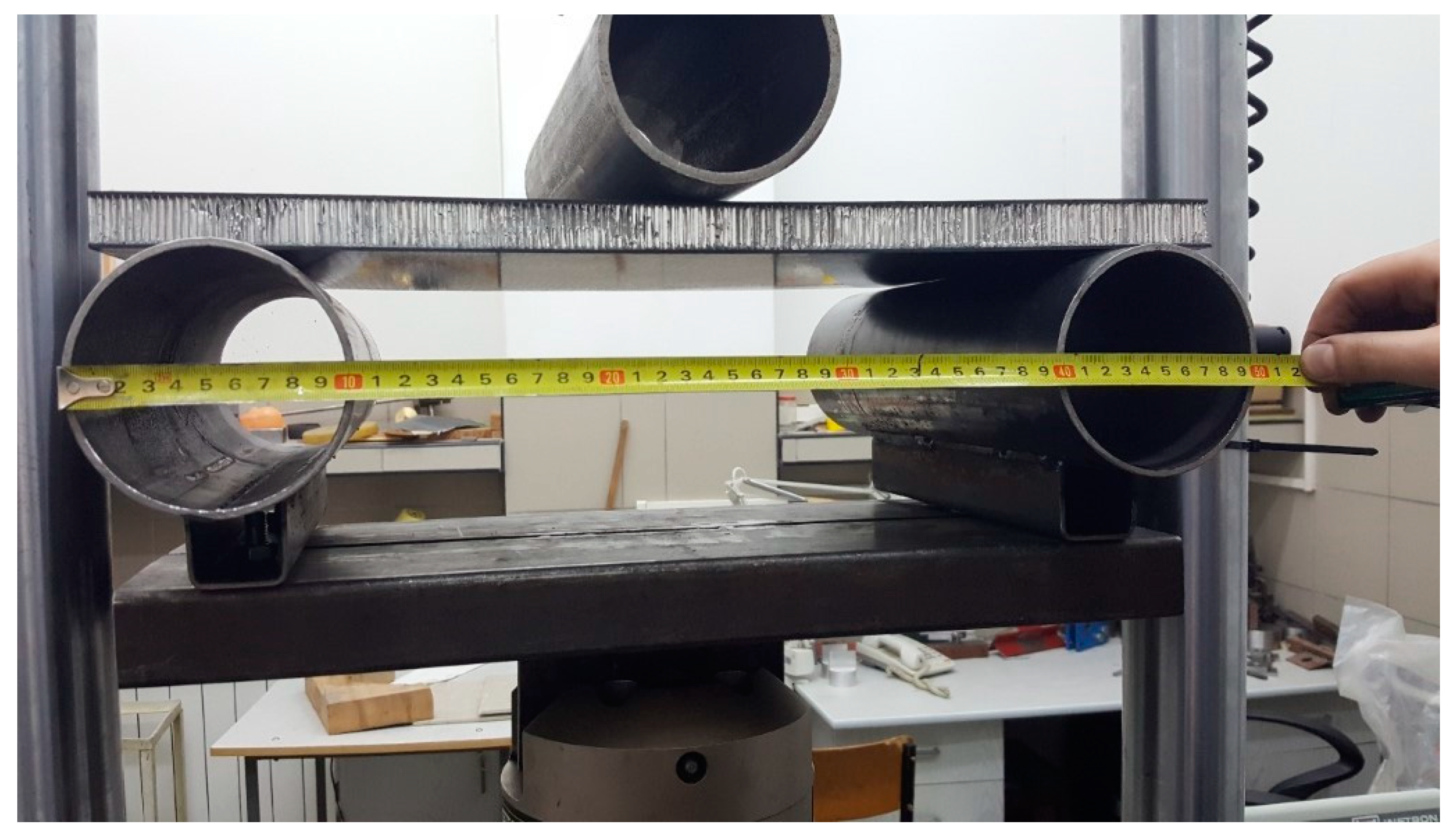
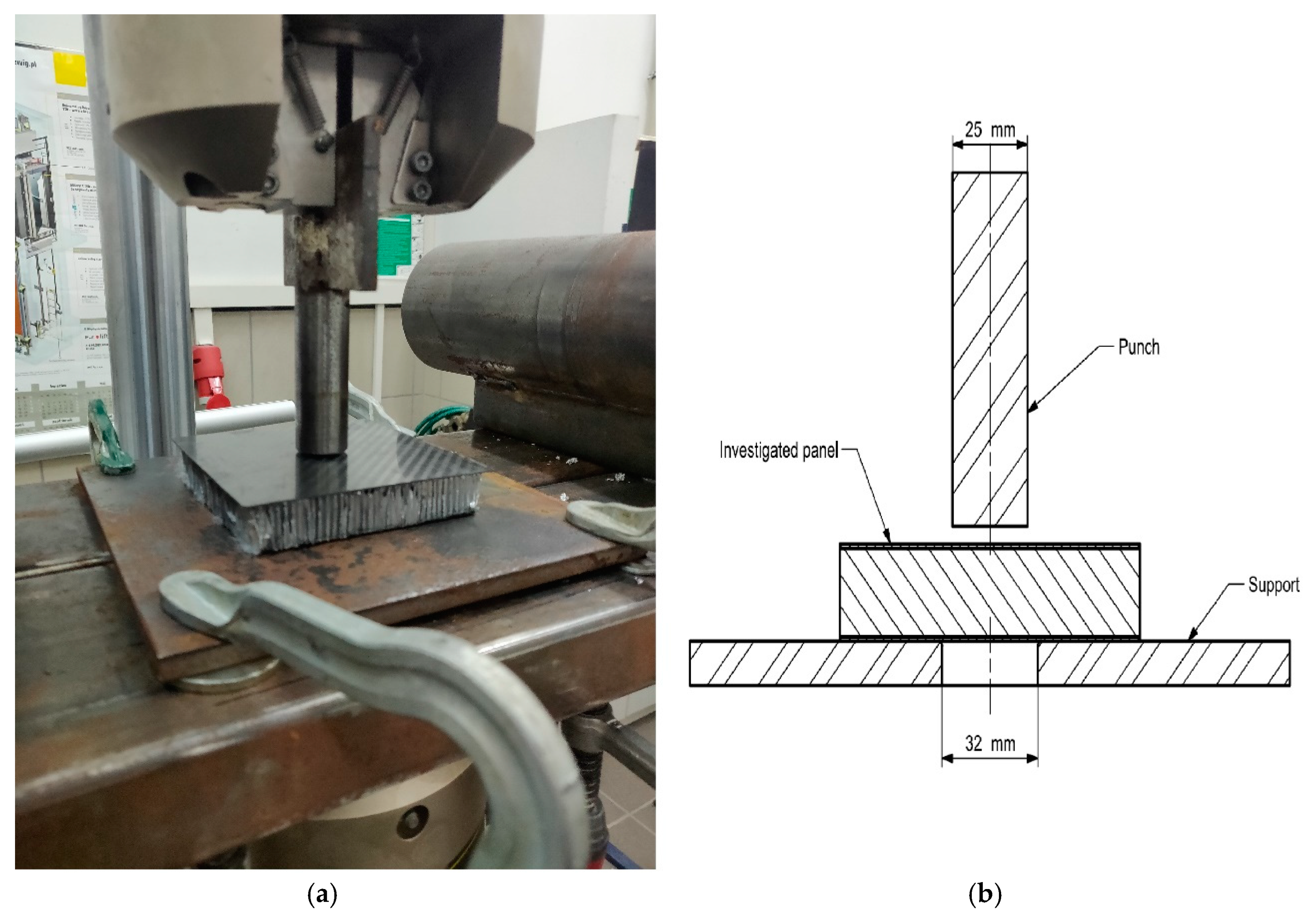
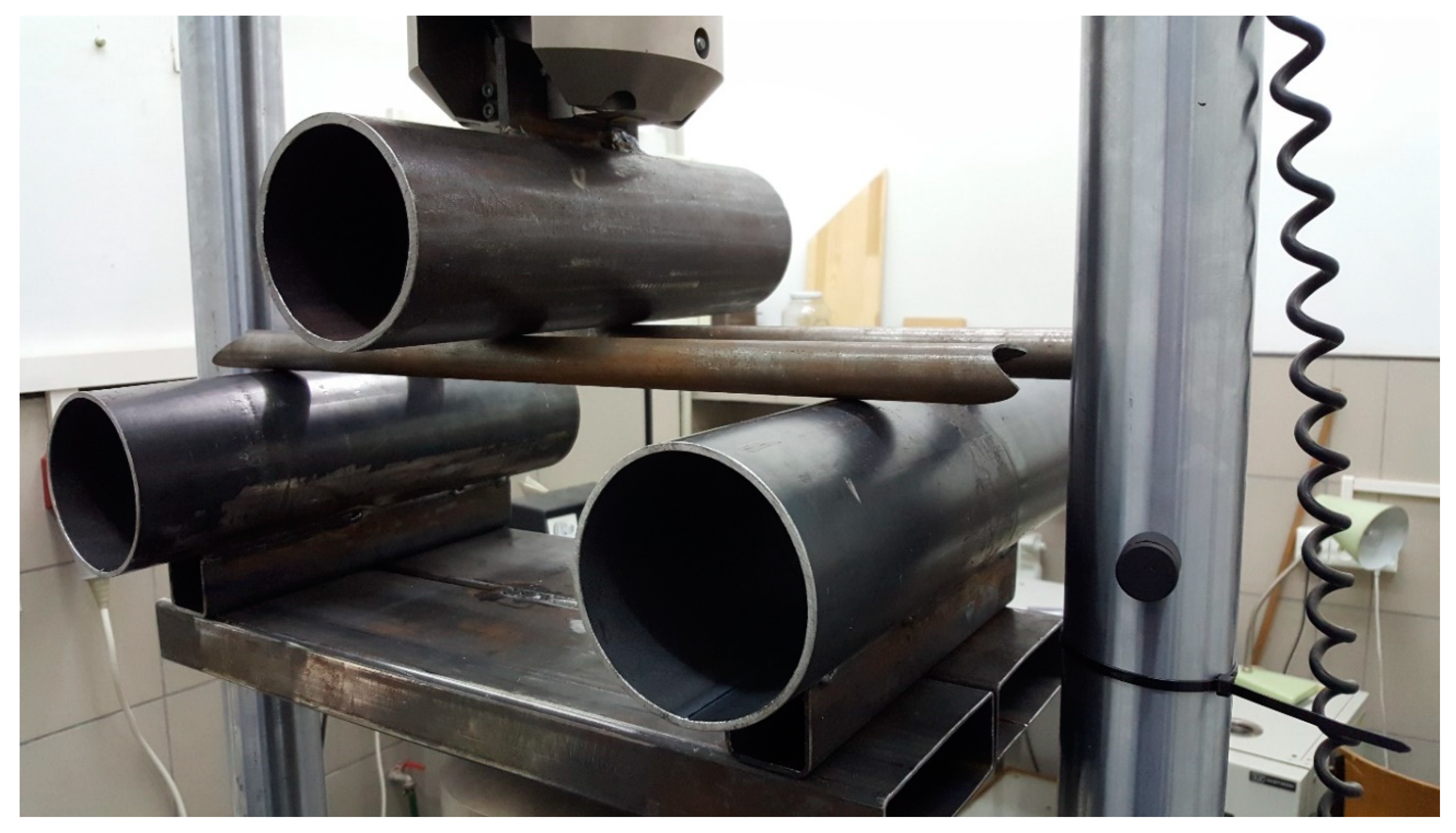
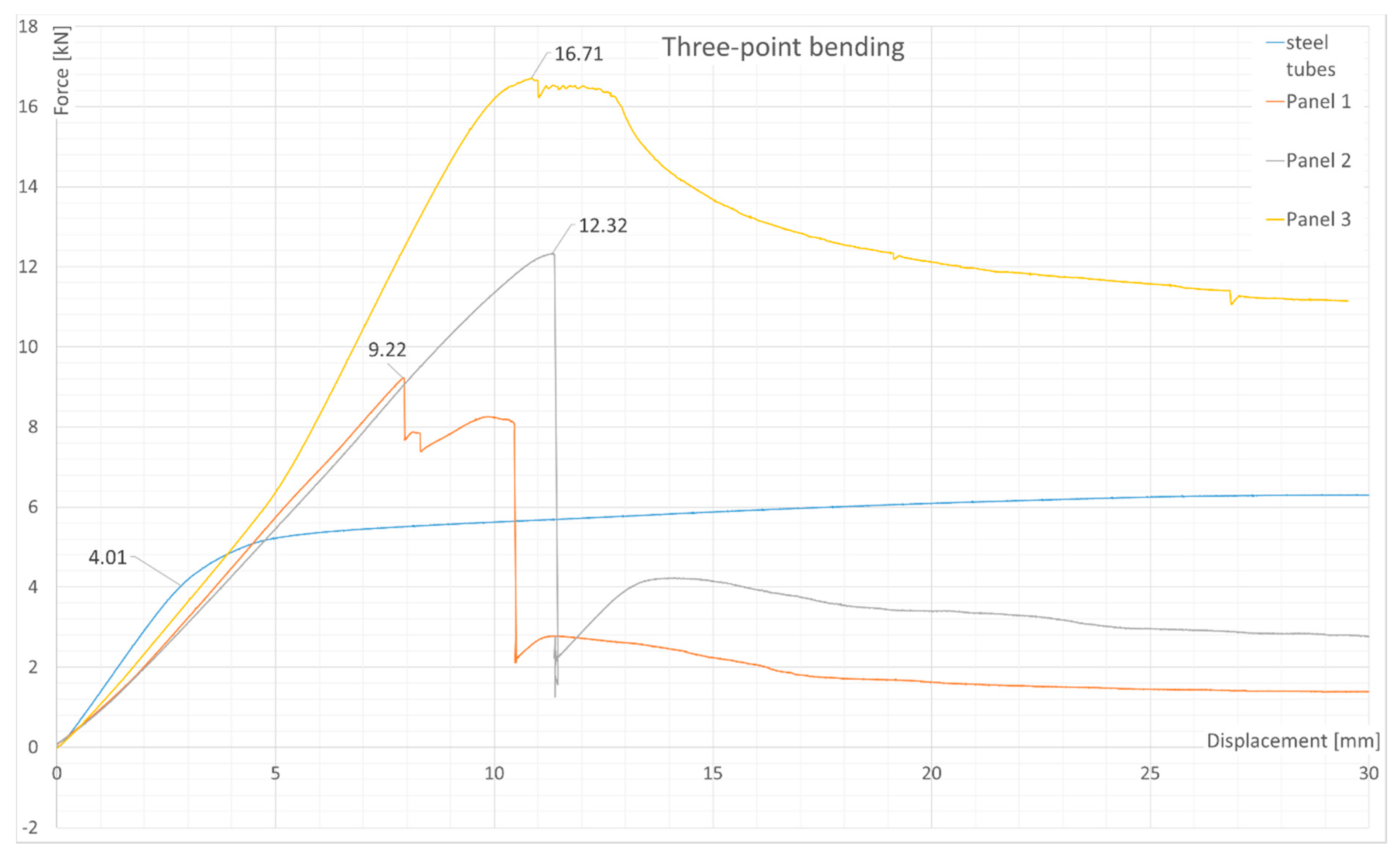
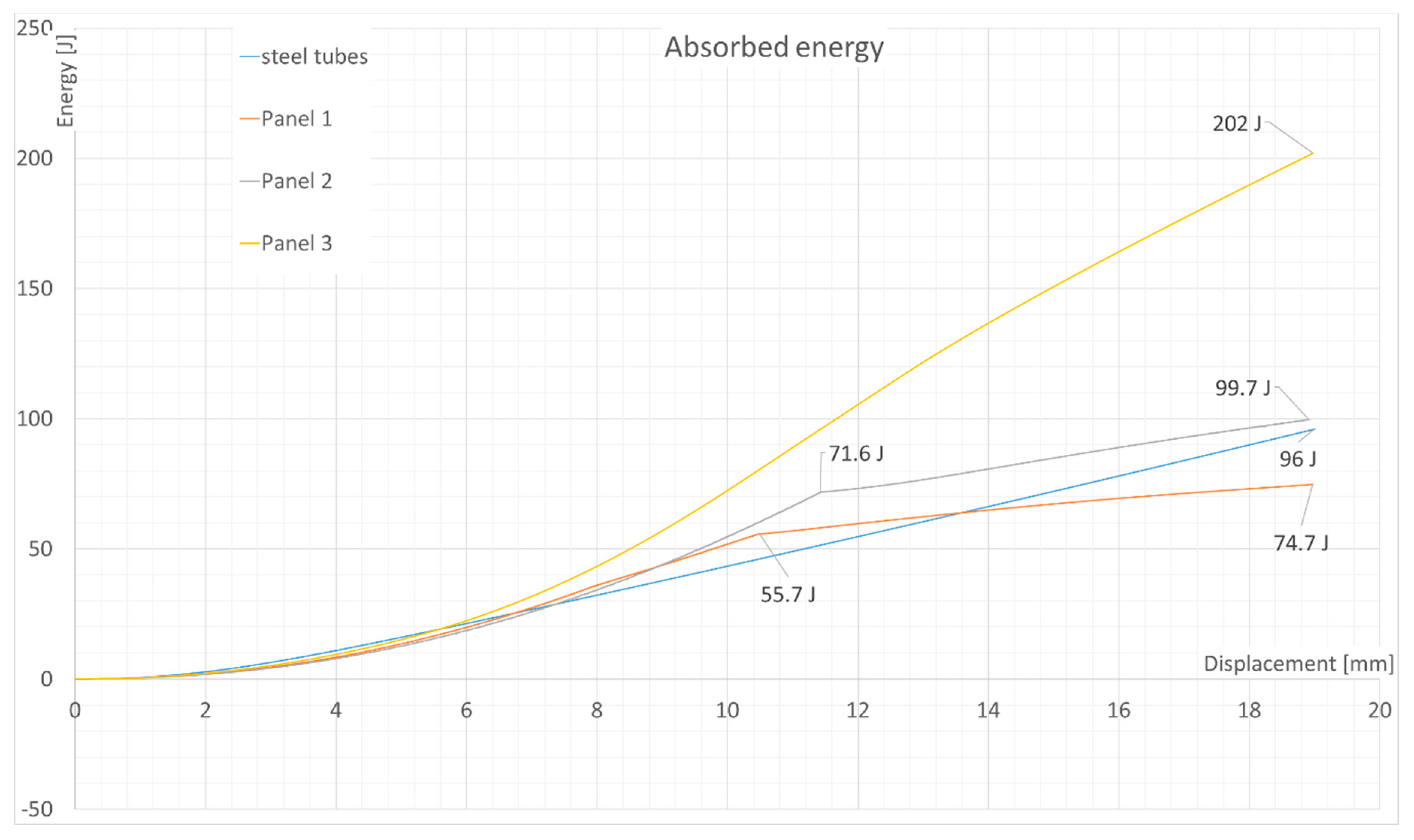
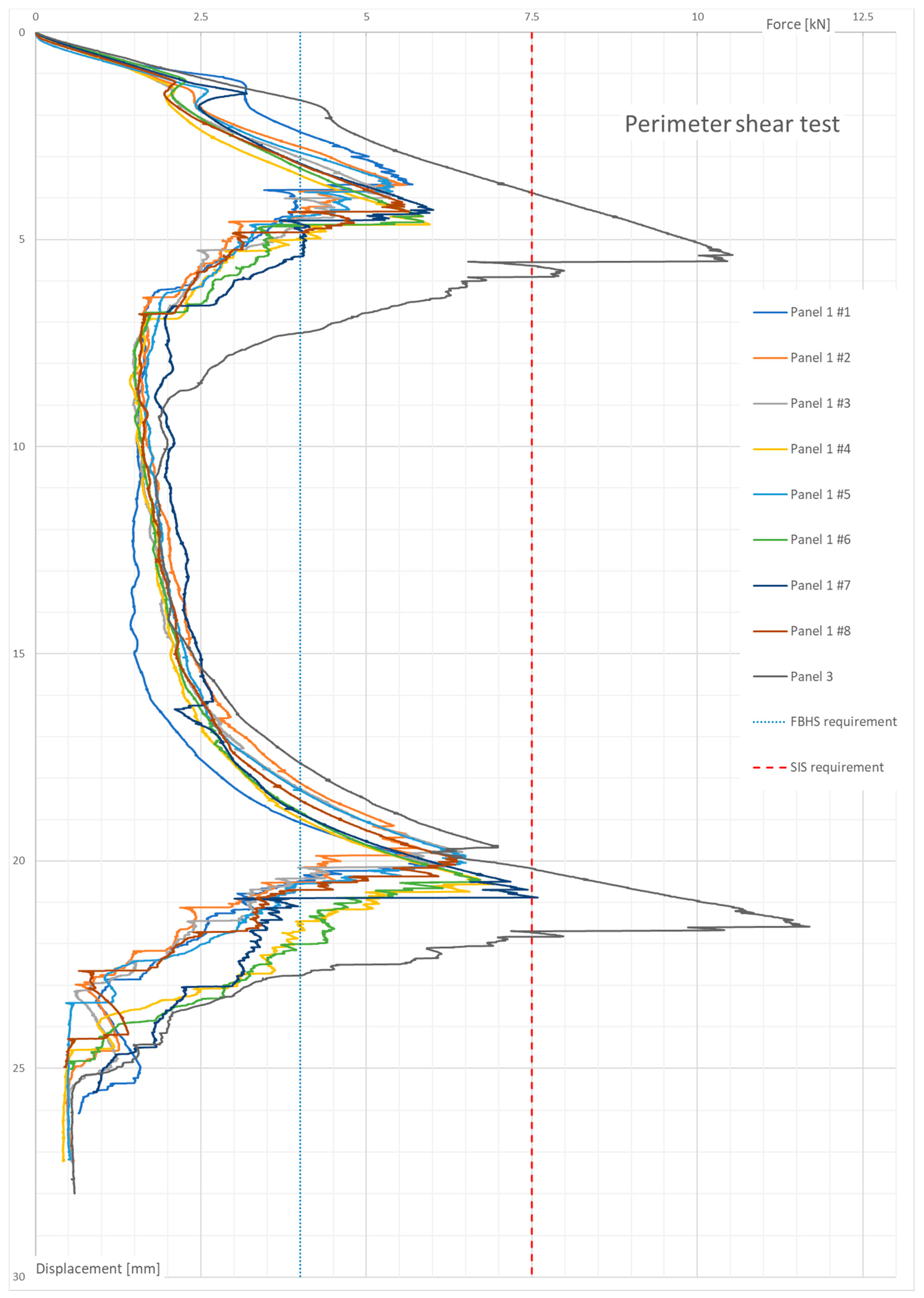
| Property | Value |
|---|---|
| Cell size [mm] | 3.2 |
| Foil thickness/wall thickness [microns] | 35 |
| Plate Shear Modulus (lengthwise) [MPa] | 482 |
| Plate Shear Strength (lengthwise) [MPa] | 2.34 |
| Plate Shear Modulus (widthwise) [MPa] | 214 |
| Plate Shear Strength (widthwise) [MPa] | 1.52 |
| Compressive Strength (stabilized) [MPa] | 3.85 |
| Thickness [mm] | 15 or 20 |
| Panel 1 | Panel 2 | Panel 3 | Steel Tubes (×2) | |
|---|---|---|---|---|
| Number of 210 gsm plies | 4 | 4 | 8 | - |
| Layup | (0, 90, −45, 45) | (0, 90, −45, 45) | (−45, 45, 90, −45, 45, 90, 90, 90) | - |
| Core thickness (mm) | 15 | 15 | 15 | - |
| Weight (kg) | 0.52 | 0.53 | 1.04 | 0.51 |
| Technology (step process) | 2 | 1 | 1 | - |
| Panel 1 | Panel 2 | Panel 3 | Steel Tubes | |
|---|---|---|---|---|
| Maximum load (kN) | 9.22 | 12.32 | 16.71 | 6.30 |
| Energy absorbed at displacement of 19 mm (J) | 74.74 | 99.66 | 202 | 96.01 |
| Stress at failure (MPa) | 222 | 297 | 148 | 391 * |
| Test Sample | Panel 1 | Panel 3 |
|---|---|---|
| Peak Force—1st (kN) | 10.52 | |
| Peak Force—2nd (kN) | 11.69 | |
| Energy absorbed at displacement of 19 mm (J) | 71.95 |
Publisher’s Note: MDPI stays neutral with regard to jurisdictional claims in published maps and institutional affiliations. |
© 2020 by the authors. Licensee MDPI, Basel, Switzerland. This article is an open access article distributed under the terms and conditions of the Creative Commons Attribution (CC BY) license (http://creativecommons.org/licenses/by/4.0/).
Share and Cite
Mogilski, M.; Jabłoński, M.; Deroszewska, M.; Saraczyn, R.; Tracz, J.; Kowalik, M.; Rządkowski, W. Investigation of Energy Absorbed by Composite Panels with Honeycomb Aluminum Alloy Core. Materials 2020, 13, 5807. https://doi.org/10.3390/ma13245807
Mogilski M, Jabłoński M, Deroszewska M, Saraczyn R, Tracz J, Kowalik M, Rządkowski W. Investigation of Energy Absorbed by Composite Panels with Honeycomb Aluminum Alloy Core. Materials. 2020; 13(24):5807. https://doi.org/10.3390/ma13245807
Chicago/Turabian StyleMogilski, Maciej, Maciej Jabłoński, Martyna Deroszewska, Robert Saraczyn, Jan Tracz, Michał Kowalik, and Witold Rządkowski. 2020. "Investigation of Energy Absorbed by Composite Panels with Honeycomb Aluminum Alloy Core" Materials 13, no. 24: 5807. https://doi.org/10.3390/ma13245807






